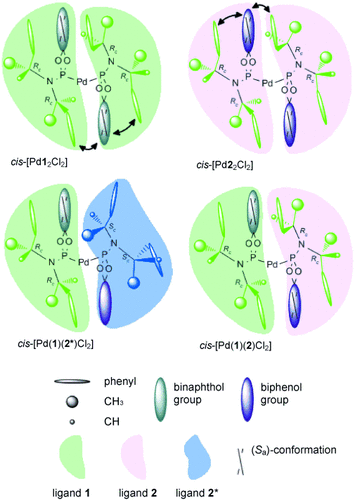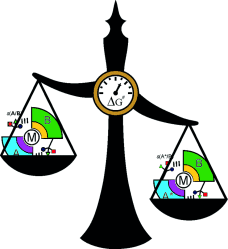 Fakultäten
Fakultäten
![]()
Relaxation Dispersion NMR to Reveal Fast Dynamics in Brønsted Acid Catalysis: Influence of Sterics and H-Bond Strength on Conformations and Substrate Hopping
N. Lokesh, J. Hioe, J. Gramüller, R.M. Gschwind, J. Am. Chem. Soc. 2019
NMR provides both structural and dynamic information, which is key to connecting intermediates and to understanding reaction pathways. However, fast exchanging catalytic intermediates are often inaccessible by conventional NMR due its limited time resolution. Here, we show the combined application of the 1H off-resonance R1ρ NMR method and low temperature (185–175 K) to resolve intermediates exchanging on a μs time scale (ns at room temperature). The potential of the approach is demonstrated on chiral phosphoric acid (CPA) catalysts in their complexes with imines. The otherwise inaccessible exchange kinetics of the E-I ? E-II imine conformations and thermodynamic E-I:E-II imine ratios inside the catalyst pocket are experimentally determined and corroborated by calculations. The E-I ? E-II exchange rate constants (kex185 K) for different catalyst–substrate binary complexes varied between 2500 and 19?000 s–1 (τex = 500–50 μs). Theoretical analysis of these exchange rate constants revealed the involvement of an intermediary tilted conformation E-III, which structurally resembles the hydride transfer transition state. The main E-I and E-II exchange pathway is a hydrogen bond strength dependent tilting–switching–tilting mechanism via a bifurcated hydrogen bond as a transition state. The reduction in the sterics of the catalyst showed an accelerated switching process by at least an order of magnitude and enabled an additional rotational pathway. Hence, the exchange process is mainly a function of the intrinsic properties of the 3,3′-substituents of the catalyst. Overall, we believe that the present study opens a new dimension in catalysis via experimental access to structures, populations, and kinetics of catalyst–substrate complexes on the μs time scale by the 1H off-resonance R1ρ method.

__________________________________________________________________________________________________
Brønsted Acid Catalysis – The Effect of 3,3’-Substituents on the Structural Space and the Stabilization of Imine/Phosphoric Acid Complexes
Chem. Sci. 2019, 10, 5226-5234.
__________________________________________________________________________________________________
Structures and Interligand Interaction Pattern of Phosphoramidite Pd Complexes by NMR Spectroscopy: Modulations in Extended Interaction Surfaces as Stereoselection Mode of a Privileged Class of Ligands
During the last decade, phosphoramidites have been established as a so?called privileged class of ligands in various transition metal catalyses. However, the interactions responsible for their favorable properties have hitherto remained elusive. To address this issue, the formation trends, structural features, and interligand interaction patterns of several trans- and cis-[PdLL′Cl2] complexes have been investigated by NMR spectroscopy. The energetic contribution of their interligand interactions has been measured experimentally using the supramolecular balance for transition?metal complexes. The resulting energetics combined with an analysis of the electrostatic potential surfaces reveal that in phosphoramidites not only the aryl groups but the complete (CH)CH3Ph moieties of the amine side chains form extended quasi-planar CH?π and π?π interaction surfaces. Application of the supramolecular balance has shown that modulations in these extended interaction surfaces cause energetic differences that are relevant to enantioselective catalysis. In addition, the energetics of these interligand interactions are quite independent of the actual structures of the complexes. This is shown by similar formation and aggregation trends of complexes with the same ligand but different structures. The extended quasi?planar electrostatic interaction surface of the (CH)CH3Ph moiety explains the known pattern of successful ligand modulation and the substrate specificity of phosphoramidites. Thus, we propose modulations in these extended CH-π and π-π interaction areas as a refined stereoselection mode for these ligands. Based on the example of phosphoramidites, this study reveals three general features potentially applicable to various ligands in asymmetric catalysis. First, specific combinations of alkyl and aryl moieties can be used to create extended anisotropic interaction areas. Second, modulations in these interaction surfaces cause energetic differences that are relevant to catalytic applications. Third, bulky substituents with matching complementary interaction surfaces should not only be considered in terms of steric hindrance but also in terms of attractive and repulsive interactions, a feature that may often be underestimated in asymmetric catalysis.

__________________________________________________________________________________________________
The Supramolecular Balance for Transition-Metal Complexes: Assessment of Noncovalent Interactions in Phosphoramidite Palladium Complexes
The virtue of enantiomers: A general method has been developed for measuring the individual contributions of noncovalent interactions within transition-metal complexes and dissecting them from electronic effects. On Pd complexes with one enantiopure and two enantiomeric phosphoramidite ligands, it was experimentally shown that modulations in extended CH–π and π–π interaction interfaces provide a ΔΔG value that is significant for stereoselection.
Phone: 0941 943-4626
Fax: 0941 943-4617
Room: CH23.1.80
E-Mail




